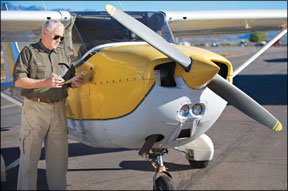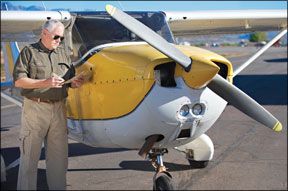We all work hard to develop the skills necessary to pass a checkride. A lot of effort and expense is involved. But we often lose sight of the real objective-not just building those skills to pass a checkride, but to keep those skills sharp so that we might call upon them when theyre needed. One mechanism to help us do that efficiently is a proficiency checklist, one inspired by an Aviation Safety article enough years ago that its been lost in the easily accessed archives. Recently

288
weve gotten some feedback from long-time readers that they liked the article and still use the ideas presented there. They suggested we revisit the idea and present it again.
Given the extraordinary cost of fuel and flying today, its become ever more difficult to allocate the money to just go up and play or even to simply maintain proficiency. Increasingly, weve got to have a specified purpose to justify going flying. Before we delve into the proficiency checklist, though, lets take a look at the way a typical GA pilot maintains proficiency.
Acute Proficiency
Unfortunately for many of us, the day of our last checkride also was the day our competence peaked. Since then, we seldom if ever practice the skills we worked so hard to develop. Instead, we use our planes for business or pleasure travel and typically just fly long, straight lines in good to moderate weather. Its even possible the only real turns or airwork we perform are in the traffic patterns at both ends of the trip. We get really great at maintaining altitude and heading without paying much attention because we get a lot of practice. But in so doing we convince ourselves weve honed all our skills-until we run into a difficult situation, like a challenging approach, we used to be able to handle with little concern. Suddenly, we find ourselves making all the same stupid mistakes we made in training. When this happens to the prudent pilot, he will hire an instructor and spend a bucket of money regaining those old skills, typically only to lose them again. The imprudent pilot wont think much about it until it happens again, this time perhaps scaring himself to action. Or worse.
Clearly there are some aspects of proficiency, or at least currency, that wont wait. For example, in order to be legal to carry passengers, we must have made three takeoffs and landings within the last 90 days. So, if were not current, well typically just hop in the plane and go around the patch a few times before loading our passengers. By doing this were legally current but, some might argue, not necessarily proficient. The same is true for instrument pilots who have the requirement for approaches of varying types, holds, etc., to be considered legally current to fly IFR within the system. If were just a little out of currency, we can go fill in the missing items on our own. If its been too long, we have to get a full instrument proficiency check from an instructor.
One might liken this method of maintaining proficiency to the way we maintain our airplanes. When our plane is within its annual inspection year, if something breaks we get it fixed. Only when necessary, though, do we have a full inspection to make sure everything is up to par.
Theres another way to maintain a plane, however. Most commercial operators and airlines use what is called a progressive maintenance program. In this approach to maintenance, a little inspection and maintenance is performed regularly instead of waiting for a major event. You can even think of this as continuous maintenance rather than periodic maintenance. It turns out this is a much more efficient approach to maintenance in that the plane is seldom down for maintenance longer than a few hours and the plane can be maintained to tighter overall standards.
Why not maintain our pilot skills in a similar progressive fashion rather than use the episodic process we most often use? Theres no reason not to and those who do, find that flying is more enjoyable, plus theyre generally more proficient and use their flying time much more efficiently.
Chronic Proficiency
The idea behind a proficiency checklist is to help you create and maintain a progressive proficiency program so you are far less likely to lose proficiency and end up needing to spend significant effort to regain it.
Lets look at a simple example. To get our private pilot certificate, we have to demonstrate a minimum competence level in crosswind landings. A typical small plane is able to handle 15 to 20 knots of direct (90-degree) crosswind. A fresh private pilot probably can handle that as well, although there might be some white knuckles involved. Most airports are very intelligently laid out with respect to the prevailing wind and there are usually a couple of runways to accommodate nearly any wind. The reality, then, is that its seldom if ever necessary for the average private pilot to have to handle much more than maybe 5 to 10 knots of direct crosswind. To see how this works, consider a hypothetical airport with runways arranged north-south and east-west. No matter what the wind direction is, if you pick the right runway youll never have more than a 45-degree crosswind. Even a 20-knot wind at 45 degrees to the runway translates to only about 14 knots of direct 90-degree crosswind.
Plus, its rather uncommon for a meaningful crosswind at most airports to even be as much as 45 degrees to the runway in use because the stronger winds are usually very consistently from the same general direction and the runways are built knowing that. So, even an active pilot will seldom encounter much more than a 10-knot direct crosswind.
However, “seldom” doesnt mean “never.” If our hapless pilot isnt prepared he may find himself faced with a wind that is more than he can handle. Worse, he may not realize it until he tries. However, had he continued to practice those crosswind landings, when he finds his local airport is reporting 15-gusting-25 with the direction variable across 100 degrees, hell be ready. And that brings us back to the proficiency checklist.
Your Proficiency Checklist
The idea behind a proficiency checklist is to make a list of skills, maneuvers or simple tasks at which you should remain proficient. Then, identify how often you must practice each one to maintain an acceptable level of proficiency. Take our crosswind landing again, for instance. The newly minted private pilot may need to go find a runway with a good crosswind and practice landing as often as, say, every month. Once he has 1000 hours in the logbook, though, handling even the worst crosswind may be more a matter of muscle memory than thought and once a year may be frequent enough practice to keep the muscles from forgetting.
But we said above this was a more efficient approach to maintaining proficiency. If you have to specifically go out and practice something, this approach isnt much different. The key to this whole checklist idea is to work things into your normal flying as much as possible. Before you go on that trip to the golf resort next weekend, take a look at your checklist and see whats due, what you need to practice. If crosswind landings come up, make a point of asking for a different runway at the destination, or even just monitoring the weather along the route for an airport where you can flex those muscles and improve their memory. This way, things can actually be done with little or no additional time. Also, doing it this way can even add a fun dimension to your trip: Instead of simply watching the distance-to-destination count down on the GPS, you can spend the time doing something useful and challenging.
Okay-so what goes into a proficiency checklist? Well, you should put everything in there at which you either want or need to remain proficient. A good place to start is with the Practical Test Standards for each certificate or rating you have. List every task in the PTS. Group them into logical order, much as they are in the PTS. If you have multiple certificates and ratings (private, commercial, instrument) build just one list with similar and related tasks grouped together. You can remove things youll naturally do in the course of your flying, such as normal takeoffs and landings, maintaining course and altitude, etc. Of course, you can add anything else you want.
Next, decide how often you really need to practice each item. Be conservative, but realistic. Its better to make it too often than not often enough. Youre building a document that will be frequently changing, so dont feel you have to get it right the first time. Next is the hard part where you really have to be brutally honest with yourself: Identify those items that you really struggle with-or are afraid of doing-and make sure you do them often. At the least, cover each item once a year.
Then, organize all this in a grid with the items to practice down the left side and a timeline across the top. That timeline should have enough granularity to reflect the frequency with which you normally fly. If you fly every week, the timeline would have 52 slots. If you only fly monthly, you need 12 slots. Monthly should be a practical minimum. For each item to be practiced, under the timeline in the appropriate place for the frequency youve decided to practice that item, put a box to be checked. Carry that checklist with you when you fly and check off each item as you complete them satisfactorily.
Use Your Checklist
The idea behind this progressive proficiency checklist is to routinely incorporate items you need to practice into planned flights, so you seldom have to go up just to practice. Say youve got to do some steep turns on your flight to grandmas for the weekend. Take off VFR and go to the practice area thats along your route. Do a couple of steep turns and proceed to your destination. No big deal-total time the training cost you was the time required for the turns themselves, which should be less than two minutes a piece for each turn. Even with todays fuel prices, surely you can afford 10 minutes for, say six or eight turns.
Need to practice some departure stalls? Okay; do them on departure once youve climbed a few thousand feet, then simply proceed on course. Or, even if youre just going flying for fun, as reader Joe Budge suggests, “Whenever I want to simply go bore holes in the sky, the empty squares on the proficiency checklist give me a pretty good idea of which hole to go bore.”
Yes, some of the more “interesting” maneuvers may alarm your passengers. But, youve briefed them before takeoff per the FARs, right? And, yes, some aircraft operating limitations may not allow you to do everything on your list with, say, passengers aboard or luggage in a baggage compartment. Youll simply bypass that item and perform it next time the airplane is less loaded.
Using your proficiency checklist will make each flight more interesting and will in the long run make you more proficient in the most timely way possible. Youll save wear and tear on the airplane, plus have the opportunity to practice your planning and maintain a written record of your proficiency. In the process, youll also save precious fuel and minimize your operating expenses, something which could mean the difference between keeping or selling the airplane. It just doesnt get much better than that!
Frank Bowlin is a regular contributor and airline pilot who still uses full flaps and practices something on every flight.




